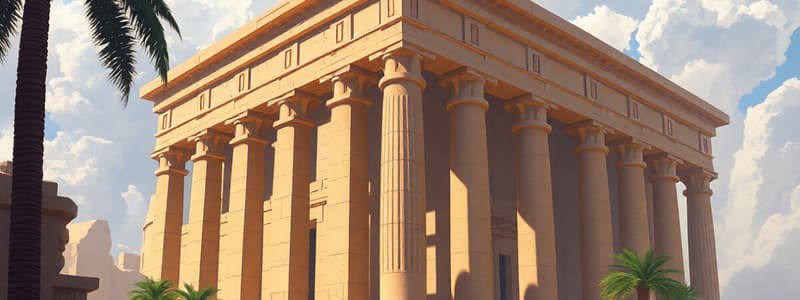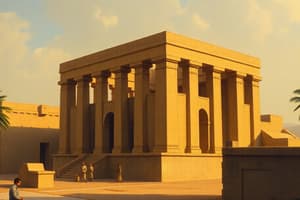Podcast
Questions and Answers
What is the name of the mineral that was of greatest importance to Greek architecture?
What is the name of the mineral that was of greatest importance to Greek architecture?
Marble
What architectural term is used to describe a building that is free from any historical style such as classical, gothic or renaissance?
What architectural term is used to describe a building that is free from any historical style such as classical, gothic or renaissance?
Art Noveau
What is the name of the temple generally considered as being the most nearly perfect building ever erected?
What is the name of the temple generally considered as being the most nearly perfect building ever erected?
Parthenon
What is the name of the architect who erected the imposing entrance to the Acropolis?
What is the name of the architect who erected the imposing entrance to the Acropolis?
What is the name of the tomb of the pharaohs in Egyptian architecture?
What is the name of the tomb of the pharaohs in Egyptian architecture?
What is the name of the architect who designed the Chrysler Building in New York?
What is the name of the architect who designed the Chrysler Building in New York?
Who is the architect of the Taj Mahal?
Who is the architect of the Taj Mahal?
Who is the architect of the Sagrada Familia in Barcelona?
Who is the architect of the Sagrada Familia in Barcelona?
What is the name of the architect who designed the Robinson Galleria?
What is the name of the architect who designed the Robinson Galleria?
What is the name of the architect who designed the Lung Center of the Philippines?
What is the name of the architect who designed the Lung Center of the Philippines?
What is the name of the architect who designed the Einstein Tower?
What is the name of the architect who designed the Einstein Tower?
What is the name of the architect who designed the Batasang Pambansa?
What is the name of the architect who designed the Batasang Pambansa?
Flashcards
Pyramid
Pyramid
A monumental tomb built for Egyptian pharaohs.
Great Pyramid at Gizeh
Great Pyramid at Gizeh
Built during the 4th dynasty by Pharaoh Cheops, it's the largest pyramid.
Marble
Marble
A crucial material for Greek architecture provided by Greece and its domains.
Columnar trabeated
Columnar trabeated
Signup and view all the flashcards
Parthenon
Parthenon
Signup and view all the flashcards
St. Sophia, Constantinople
St. Sophia, Constantinople
Signup and view all the flashcards
Romanesque architecture
Romanesque architecture
Signup and view all the flashcards
Doric order
Doric order
Signup and view all the flashcards
Hypostyle Hall
Hypostyle Hall
Signup and view all the flashcards
Agora
Agora
Signup and view all the flashcards
Minaret
Minaret
Signup and view all the flashcards
Apotheca
Apotheca
Signup and view all the flashcards
Baroque architecture
Baroque architecture
Signup and view all the flashcards
Mudejar architecture
Mudejar architecture
Signup and view all the flashcards
Imperial Forum
Imperial Forum
Signup and view all the flashcards
Caryatid
Caryatid
Signup and view all the flashcards
Hagia Sophia
Hagia Sophia
Signup and view all the flashcards
Taj Mahal
Taj Mahal
Signup and view all the flashcards
Clepsydra
Clepsydra
Signup and view all the flashcards
Vespa
Vespa
Signup and view all the flashcards
Erechtheion
Erechtheion
Signup and view all the flashcards
Colonnade
Colonnade
Signup and view all the flashcards
Crypt
Crypt
Signup and view all the flashcards
Prytaneion
Prytaneion
Signup and view all the flashcards
Odeion
Odeion
Signup and view all the flashcards
Forum Romanum
Forum Romanum
Signup and view all the flashcards
Echinus
Echinus
Signup and view all the flashcards
Cella
Cella
Signup and view all the flashcards
Ambulatory
Ambulatory
Signup and view all the flashcards
Pediment
Pediment
Signup and view all the flashcards
Study Notes
History of Architecture
- Egyptian Architecture: Pharaoh's tombs were significant. The Great Pyramid at Giza was constructed during the 4th dynasty.
- Greek Architecture: Greek architecture predominantly used marble. It was essentially columnar trabeated. The Parthenon is a prime example, considered a nearly perfect building. The Acropolis housed important structures. The Stoa was a long colonnaded shelter.
- Roman Architecture: Utilized concrete, achieved vast interior spaces. Added the composite order to Greek orders. Notable structures include the Pantheon.
- Byzantine Architecture: Characterized by the extensive use of domical roof constructions, exemplified by structures like Hagia Sophia. Emphasized sober and dignified styling.
- Romanesque Architecture: Distinguished by the use of marble for facing walls (Italy) compared to other European regions. Notable examples include structures in Pisa. The characteristic of this style is a robust, often heavy appearance.
- Gothic Architecture: Characterized by architectural elements such as pointed arches and stained-glass windows, as well as other features.
- Renaissance Architecture: A significant revival of classical forms marked by balanced compositions, and symmetry. This era demonstrated a renewed interest in the details and forms of classical antiquity.
- Baroque Architecture: Known for ornamentation and elaborate designs.
- Modern Architecture: Features diverse styles and focuses on function and structure over elaborate ornamentation, with emphasis on innovative and functional building solutions.
- Islamic Architecture: Includes architectural features specific to the Islamic faith.
Architectural Elements and Concepts
- Orders: Greek architectural orders (Doric, Ionic, Corinthian, Composite).
- Vaults: Arch and vault structures were integral to Roman and Gothic structures, with Romanesque architecture using arches extensively.
- Columns: Supporting structures used extensively in various architectural styles, including Greek and Roman orders. They served both structural and decorative purposes.
- Walls and Facades: Varied building techniques were used to construct walls, from brickwork to stone and marble, in different architectural styles.
- Roofs: Roofing styles and materials varied considerably.
- Ornaments: Various decorative elements employed in different architectural styles (antefixes, acroteria, Anthemion, etc.).
- Interior Features: Features such as courtyards, windows, and alcoves are common in many cultures.
- Types of Buildings: Various structures such as temples, houses, palaces, and public squares are all well-defined within the architecture of different styles and cultures.
- Planning and Design: Considerations such as orientation and function are important during construction stages.
Key Figures and Architects
- Notable Architects: Individuals like Imhotep, Mnesicles, and others played significant roles in shaping architectural styles, through planning, design, and construction decisions.
- Schools and Movements: Schools and movements in architecture (e.g., Bauhaus, Art Nouveau) have impacted the development of architectural features and styles.
Studying That Suits You
Use AI to generate personalized quizzes and flashcards to suit your learning preferences.




